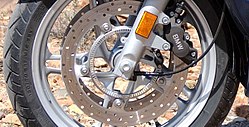Motorcycle engine
This article has multiple issues. Please help improve it or discuss these issues on the talk page. (Learn how and when to remove these messages)
No issues specified. Please specify issues, or remove this template. |



A motorcycle engine is an engine that powers a motorcycle.
Motorcycle engines may be two-stroke or four-stroke, reciprocating or Wankel, single-cylinder or multicylinder (if reciprocating), or single-rotor or twin-rotor (if Wankel). The engine typically drives the rear wheel, but some small bikes such as the Velosolex have a friction drive to the front wheel. Most engines have a gearbox of between two and six ratios, and the Honda Gold Wing touring motorcycle has a reverse gear. Power is sent to the driven wheel by belt, chain or shaft. In Europe, up till the 1970 Honda CB750, engine capacities typically ranged from about 50 cc to 750 cc; but since then machines with capacities up to 2,300 cubic centimetres (140 cu in) Triumph Rocket 3 have become common. In the USA, motorcycles with large capacities have been common for much longer.
Even today, most motorcycles still bear some resemblance to early motorised bicycles, so the engine is normally found where the crank-wheel would be on a pedal bicycle. However, some early examples like the 1921 Megola and 1935 Killinger and Freund had the engine within the driven wheel, and the Velosolex has its engine ahead of the handlebars, just above the front wheel.
History

The first motorcycles were powered by steam engines. The earliest example is the French Michaux-Perreaux steam velocipede of 1868. This was followed by the American Roper steam velocipede of 1869, and a number of other steam powered two and three wheelers, manufactured and sold to the public on through the early 20th century.[1]
Using frames based both on the earlier boneshaker and the later—and in many ways completely modern—safety bicycle design, these early steam motorcycles experimented with a variety of engine placement strategies, as well as transmission and options. While today nearly every motorcycle has its engine in the center of the frame, this became standard only around 1900-1910[verification needed] after nearly every possible engine location was tried. The modern scooter engine arrangement arrived in the 1940s[verification needed] and remains the same today.[1]
The Otto cycle gasoline internal combustion engine was first used on an experimental two-wheeler created by Gottlieb Daimler to test the practicality of such an engine in a vehicle. This motorcycle, the Daimler Reitwagen, is credited as the world's first motorcycle by many authorities, partially on the assumption that a motorcycle is defined not as any two-wheel motor vehicle, but a two-wheel internal combustion engine motor vehicle.[1] The Oxford English Dictionary, for example, defines the word motorcycle this way.[2][3] The steam cycles were also simply neglected and forgotten by many historians, even as the Michaux-Perreaux waited forty years[verification needed] on display in the National Motor Museum, Beaulieu.[verification needed][4]
In recent years, a surge in interest in clean energy has put many new electric powered two wheelers on the market, and they are registered as motorcycles or scooters, without the type of powerplant being an issue. Diesel motorcycles were also been experimented with briefly throughout the 20th century, and are again the subject of interest due to fuel economy and the needs of military logistics. The USMC has ordered a new diesel motorcycle, the M1030 M1, that can use the same fuel, JP-8, as the rest of their armored vehicles, aircraft, cars and trucks.[5]
The overwhelming majority of the motorcycles produced and used in the world today have small displacement air-cooled single-cylinder engines, both two- and four-strokes.[citation needed] In the wealthier parts of the world, Europe and Japan, larger displacements and multiple cylinders are common alongside small-displacement bikes required by various licensing and rider experience requirements, and so a very diverse range of sizes, cylinder numbers, configurations, and cooling systems are seen on the road. Many developed countries have graduated licensing, where a rider is licensed for a period of time to ride only smaller-displacement motorcycles before being allowed to ride larger ones. In the United States, there are no such mandates, and so the mix is skewed even further to the largest displacements, consumer demand drives manufacturers to offer their largest motorcycles to that country, and to export far fewer sub-600 cc (37 cu in) models to the American market.[citation needed]
Types
Almost all production motorcycles have gasoline (UK petrol) internal combustion engines. Both four-stroke and two-stroke engines are used, but strict emission laws have led to far fewer two-strokes. A few have used Wankel rotary engines, but no Wankel bikes are currently in production. Small motorcycles are air-cooled, but oil cooling or water cooling is more usual with larger machines. Some scooters use batteries and an electric motor. (The 2009 TT races introduced a new category 'TTX' for electric bikes using fuel-cells or batteries).
Most motorcycle engines are mounted transversely, with the crankshaft across the frame, but others have the crankshaft longitudinal, along the frame. Transverse engines usually have chain or belt final-drive, while longitudinal mounting is more suitable for shaft final-drive.
Motor scooters have the engine as part of the rear suspension, so the engine not fixed rigidly to the main frame. Instead, the combined engine-transmission-swingarm assembly is pivoted to follow the road surface and is part of the "unsprung weight". The chain final-drive of scooters runs in an oil-bath within the engine casings. "Step-throughs" motorcycles may have a rigidly fixed engine, or may have a scooter-type arrangement.
Two-stroke and four-stroke
Two-stroke engines have fewer moving parts than four-stroke engines, and produce twice the number of power strokes; consequently, two-stroke engines are more powerful for their mass. Two-strokes offer stronger acceleration, but similar top speed compared to a four-stroke engine. [citation needed] They are also easier to start. [citation needed] Two-stroke engines have shorter life due to poorer piston lubrication, since lubrication comes from the fuel-oil mix.
Four-stroke engines are generally associated with a wider power band making for somewhat gentler power delivery, but technology such as reed valves and exhaust power-valve systems has improved ride-ability on two-strokes.[citation needed] Fuel economy is also better in four-strokes due to more complete combustion of the intake charge in four-stroke engines.
Nevertheless, two-strokes have been largely replaced on motorcycles in developed nations due to their environmental disadvantages. Cylinder lubrication is necessarily total-loss and this inevitably leads to a smokey exhaust, particularly on wide throttle openings. Two-stroke-engined motorcycles continue to be made in large numbers, but mostly low-power mopeds, small scooters and step-through underbones where they still compete strongly with four-strokes (including the highest-selling motorcycle of all time, the 50 cc Honda Super Cub). The major markets of two-stroke motorcycles are in developing nations.
Cylinder heads (four-stroke)
Cylinder head design has a significant effect on the efficiency of combustion, and hence the power output of the engine. The head may be flat, in which case the combustion chamber resides within the cylinder and/or a depression in the piston crown, but usually a "dome" within the cylinder head provides most of the combustion volume. In motorcycles, valve gear tends to be side valve, overhead valve (ohv) with pushrod operation, (single)overhead cam, (s)ohc, and double overhead cam, dohc. An ohc (or dohc) cylinder head will have at least two valves per cylinder (1 inlet and 1 exhaust), but some have three (2 inlet and 1 exhaust), or four (2 inlet and 2 exhaust), or even five (3 inlet and 2 exhaust). Cylinder heads are the hottest part of the engine and require adequate cooling, typically air cooling, oil cooling or liquid cooling.
Some motorcycles such as Harley-Davidsons, Moto Guzzis and BMWs become identifiable by their cylinder-head types, namely airhead, panhead, oilhead, and even knucklehead.[4][6] The Ducati desmos head enables higher rpm to be achieved without the danger of "valve bounce".
Valve control (four-stroke)
In a side-valve engine, the valves are operated from the "underhead" cam without special valve gear. OHV engines have valves operated by pushrods. OHC and DOHC engines have overhead camshafts typically operated by chain, belt, gear train or bevel gear drive.
Honda equipped the CBR400F with REV ( described as "revolution responding type valve pausing mechanism") in 1983,[7] This system enabled to switch over the number of valve operations per cylinder between low and medium speed revolution range and high speed revolution range. In 2002, Honda introduced HYPER VTEC in the VFR800 Interceptor. In 2006, Kawasaki introduced VVT in the Concours 14.[8]
Unit construction
Engines and gearboxes were originally separate items, the gearbox being driven by a "primary chain". Later designs combined the two elements into a single "unit construction". Some manufacturers, such as Norton and Enfield continued with "pre-unit" construction until recently, and Harley-Davidson still makes pre-unit engines today.
In the early 1960s, BSA introduced new short-stroke unit construction 500 and 650cc parallel twins to replace their existing pre-unit long-stroke engines. Triumph modified their large pre-unit 500 and 650cc parallel twins into unit-construction engines. The smaller Triumph 350 and 500cc twins had been unit construction from their introduction in 1957. The decision by Lucas to discontinue making dynamos and magnetos, and to produce only alternators and coil ignition systems, was a significant factor in forcing the redesign.
Traditionally, engines and gearboxes had separate lubrication systems with different grades of oil; but modern practice is to use the same oil for both.
Cylinders and configuration
The majority of motorcycle engines are configured as singles, parallel twins, triples, fours and sixes; and all these may be inline or transverse. Vee engines include V-twins and V-fours, and horizontally opposed engines include flat-twins, flat-fours and flat-sixes. Wankel engines are either single-rotor or twin-rotor. Bigger bikes tend to have more cylinders for smoothness and increased power. Modern singles range in capacity from 50 cc to 660 cc, twins from 175 cc to 1800 cc, triples from 380 cc to 2,300 cc, and so on.
Single

Single-cylinder engines (aka "singles" or "thumpers") have the cylinder vertical, inclined or horizontal, the last type most common in step-through motorcycles. Single-cylinder engines require both a larger flywheel and a heavier-duty gearbox than multicylinder engines. Small singles are cheap to build and maintain and are suitable as cheap utility motorcycles.
Until the mid-1960s, road-racing machines (such as Matchless, AJS and Norton) tended to be large singles, but since then multicylinder racers have become the norm. Off-road bikes still use single-cylinder engines; but the new category of dual-sport bikes tend to use twins or triples.
Twin
- Parallel-twin
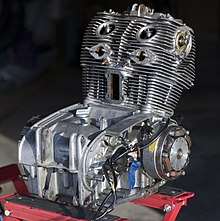
Starting with Edward Turner's 1937 Triumph Speed Twin design, and until the mid 1970s, the parallel twin was the most common British motorcycle type. Parallel twins are usually mounted transversely, with the cylinders side by side above the crankshaft, and with exhaust pipes at the front, in the cool airstream. Longitudinal twins (aka "inline twins") include the 500 cc Sunbeam S7 and S8. There are three crankshaft configurations for this engine: 360°, 180°, and the newer 270°. Parallel twins usually have only two main bearings.
- V-twin

In a V-twin engine the cylinders form a "V" around the crankshaft. A Vee-angle of 90°, as used by Ducati and Moto Guzzi, can give perfect primary and secondary balance, with a pleasingly irregular firing order. A lesser angle gives a more compact motor, but one which is prone to vibration, such as 42° (Indian), 45° (Harley-Davidson), 52° Honda, and 60° (Aprilia). Most V-twins have a single crankpin shared by side-by-side connecting rods (so that the cylinders are slightly offset), but a variation is to have a single crankpin with "fork & blade" con-rods, to keep the cylinders in line. Non-90° V-twins may have offset crankpins to try to reduce vibration.
V-twins may be mounted either longitudinally with the cylinders protruding either side (e.g. Honda CX500 and Moto Guzzi ), or transversely,[9](e.g. Harley Davidson, Ducati, Hesketh, Vincent, Moto Morini and Aprilia). Transverse V-twins can raise difficulties in cooling the aft cylinder, and in siting the airbox, battery, aft carburetter, and aft exhaust pipe.
- Flat twin
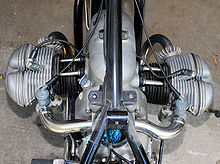
In a flat-twin (boxer) engine, the cylinders are horizontally opposed. The boxer has perfect primary balance, balance only a small rocking couple, and (unlike a V-twin), regular firing intervals, producing very low vibration levels (without the use of counterbalance shafts). Such engines are usually mounted longitudinally with the cylinders protrude into the airstream, so that a flat twin can satisfactorily be air-cooled. Flats twins are made by BMW, Ural, Harley-Davidson's WW2 "XA" model, Marusho, and historically by Douglas. The longitudinal mounting makes the flat twin highly suitable for shaft final drive, but (arguably, perversely) the Douglas Dragonfly had chain-drive.
Some early motorcycles used transversely mounted flat twin engines.
- Tandem twin
The Tandem Twin where the cylinders are longitudinal, and have two cranks geared together such as Kawasaki's KR250 road bike and KR250 and KR350 GP Bikes. A tandem twin is effectively a pair of geared singles, and is to be distinguished from an inline twin such as the Sunbeam S7. Tandem twins are suitable primarily for two-stroke racers.
Triple
- Inline 3

Three-cylinder (aka triples) are normally mounted transversely. The British Hinckley Triumph factory has specialised in transverse triples, although their 2,300 cc longitudinal Rocket III has an inline engine. Other examples are the Benelli' "Tre"and the Yamaha XS750. The Italian firm Laverda made a few 1,000 cc and 1,200 cc triples. Curiously, some Laverda Triples had 120° cranks, while some had 180° cranks (essentially three-quarters of a four). BMW made the K75 longitudinal 750 cc triple with the cylinders parallel to the ground. Meriden Triumph developed the 750 cc Trident, from which BSA "badge-engineered the Rocket-3.
Some triples were two-strokes. The Kawasaki triples were produced with capacities of 250, 350, 400, 500, and 750 cc in the 1970s, while Suzuki produced 380, 550, and 750 triples (the last being water-cooled). Motobecane made 350 cc and fuel-injected 500 cc triples with 3 into 4 pipes in the early seventies. Honda produced the water-cooled V-3 two-strokes MVX250 and NS400. There have been various race bike triples such as Kawasaki KR750, Suzuki TR750 transverse 3's, and Proton/Modenas KR3, Honda NS500 V-3s.
Four
Four-cylinder engines are most commonly found in a transverse-mounted inline four layout, although some are longitudinal (as in the earlier BMW K100). V-4 and boxer designs (as in the earlier Honda Gold Wing) have been produced. One of the more unusual designs was the Ariel Square Four, effectively two parallel-twin engines one in front of the other in a common crankcase – it had remarkably little vibration due to the contra-rotating crankshafts.
- Inline 4

This section needs expansion. You can help by adding to it. (April 2010) |
Since the advent of the Honda CB750 straight-four engine, straight-fours have dominated the non-cruiser street motorcycle segments. The German manufacturer Münch based their motorcycles on four-cylinder car engines (e.g. Mammut 2000 has a 2.0l with a turbo and cylinder heads by Cosworth).
- Flat 4

This section needs expansion. You can help by adding to it. (December 2009) |
A flat-4 or horizontally opposed-4 is a flat engine with four cylinders arranged horizontally in two banks of two cylinders on each side of a central crankcase. The pistons are usually mounted on the crankshaft such that opposing pistons move back and forth in opposite directions at the same time, somewhat like a boxing competitor punching their gloves together before a fight, which has led to it being referred to as a boxer engine. The configuration results in inherently good balance of the reciprocating parts, a low centre of gravity, and a very short engine length.
- V4

Honda uses V4 engines in the ST series and VFR series. As for two-stroke engines, there were four cylinders in the smaller classes such as Kawasaki's 125 cc KR3 square 4 and Yamaha's 250 cc RD500 V4 (RZ 500 in the US). Yamaha later raced transverse four TZ500/700/750's and virtually all the bikes in the last decade of the two-stroke GP500 era were fours (first squares then Vees) i.e. Honda, Kawasaki, Cagiva, Suzuki, Yamaha - Kawasaki also experimented with a trapezoidal four the 602S. Yamaha made the V4 RD500LC, and Suzuki the RG400 and RG500 square four road bikes.
- Square 4
A square four is a U engine with two cylinders on each side. This configuration was used on the Ariel Square Four motorcycle from 1931 to 1959. This design was revived as a two-stroke version on some racing Suzuki models, and their subsequent road-going version the RG500. Although some racing success was achieved, the road bikes didn't sell in great numbers, and the design was phased out in favour of in-line, four-stroke designs, as at the time two-stroke engines were quickly being superseded by more economical, reliable, and emissions-friendly four-strokes.
Five
- V5

Honda has produced five-cylinder engines for racing, the RC211V 990 cc V5. No V5 engines are currently available in commercial production motorcycles.
Just prior to their collapse, BSA planned a modular family of bike engines based around a 200 cc single. The range was to include the single, a 400 cc twin, a 600 cc triple and a 1000 cc V5. None of these motorcycles reached production.[10]
Six
- Inline 6

The 1,047 cc Honda CBX was produced from 1978 to 1982. The 1,300 cc Kawasaki KZ1300 was produced from 1979 to 1989. Benelli made the 750 cc and 900 cc the Sei from 1972 to 1978. Honda made a 250 cc straight-six GP bike. The BMW K1600GT and K1600GTL, which were launched in 2011, have a transverse-mounted 1,649 cc engine.
- Flat 6
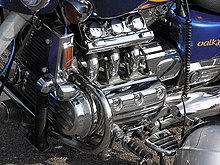
The six-cylinder engine is currently used by Honda in the Rune, Valkyrie and Gold Wing.
V8

Galbusera built a V8 in 1938, and Moto Guzzi experimented over a period of two years with its dual-overhead-cam 500 cc V8 (the Otto Cylindri) in the 1950s. Some custom and one-off motorcycles use more than six cylinders. For example, the Boss Hoss motorcycle uses (5,700 cc, 6,000 cc and 8,200 cc) Chevy V-8 crate motors. In the 1990s Daimler-Chrysler manufactured a limited number of Tomahawk concept bikes featuring a Dodge Viper's V-10 engine. Australian company Drysdale have built short runs of 750 cc V8 superbikes and 1L V8 roadgoing motorcycles, both with engines specifically developed for the purpose. No major motorcycle manufacturer has used eight or more cylinders, although Honda made the 'almost' V8 oval-piston NR750 road bike and NR500 GP bike (having eight connecting rods, for example) and Morbidelli has shown two V8 prototype road bikes, but has yet to get off the ground
Other types
This section needs expansion. You can help by adding to it. (December 2009) |
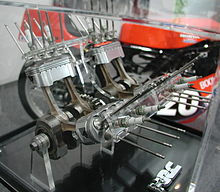
- Wankel rotary
Hercules (motorcycle), Norton Commando, ZF Sachs, Suzuki RE5
- Oval pistons
- Rotary engines
Megola, Killinger and Freund Motorcycle
- Jet engines
Electric
This section needs expansion. You can help by adding to it. (December 2009) |
Diesel
Only very small numbers of diesel engined motorcycles have ever been built. The improved fuel efficiency is offset by the increased weight, reduced acceleration and potential difficulty of starting, at least in colder climates. Enfield India built a few from 1965 onwards but is no longer doing so.[11] In November 2006, the Dutch company E.V.A. Products BV Holland announced their first diesel-powered motorcycle, its Track T-800CDI, using an 800 cc three-cylinder Daimler Chrysler diesel engine.[12]
Several armies are moving to an all-diesel engine fleet to reduce the fire risks of petrol and the need to provide two different fuels. This includes their despatch riders as well, encouraging the market for diesel motorcycles. Interest in biofuels is also likely to encourage future developments for small Diesels.
Diesels are also available in both two- and four-stroke versions.
Engine cooling
Liquid
Liquid-cooled motorcycles have a radiator (similar to the radiator on a car) which is the primary way their heat is dispersed. Coolant is constantly circulated between this radiator and the cylinders when the engine is running. While most off-road motorcycles have no radiator fan and rely on air flowing over the radiators from the forward motion of the motorcycle, many road motorcycles have a small fan attached to the radiator which is controlled by a thermostat. Some off-road motorcycles are liquid-cooled, and anti-dirt protection is attached to the radiator. The cooling effect of this fan is enough to prevent the engine overheating in most conditions, so liquid-cooled bikes are safe to use in a city, where traffic may frequently be at a standstill.
Emissions regulations and the market demand for maximum power are driving the motorcycle industry to liquid-cooling for most motorcycles. Even Harley-Davidson, a strong advocate of air-cooled motors, has begun producing a Revolution liquid-cooled engine.
Air
Most air-cooled motorcycles take advantage of air blowing past the cylinder and cylinder head while in motion to disperse heat. Frequent, sustained stationary periods may cause overheating. Some models (mostly scooters) are equipped with fans that force the air to go past the cylinder block, which solves the problem of city driving. The cylinders on air-cooled bikes are designed with fins (heat sinks) to aid in this process. Air-cooled bikes are cheaper, simpler and lighter than their water-cooled counterparts.
Oil

Some manufacturers use a hybrid cooling method where engine oil is circulated between the engine case and a small radiator. Here the oil doubles as cooling liquid, prompting the name "oil-cooling." Suzuki has produced many "oil-cooled" motorcycles. Modern BMW R-series flat-twin motorcycles, such as the R1150GS, use air and oil cooling. Polaris's Victory motorcycles use oil/air cooling exclusively.
Other components
Fuel injection and computer engine management systems are now normal on middle range and larger motorcycles and are increasingly being incorporated onto the smaller machines, partly driven by better emission control and lower maintenance but mostly by manufacturing cost considerations. Ignition systems moved from magneto in the 1950s to battery-coil-contact breaker (points), and these were increasingly superseded by Capacitor Discharge Ignition (CDI) from the 1980s. Small, single-cylinder motorcycles abandoned the flywheel magneto system with contact breakers to similar flywheel driven solid-state systems at about the same time.
Turbo and Superchargers. Superchargers (blowers) were common in the GP's, until they were banned (which didn't help the two-strokes, as pre Ernest Degners new technology, they needed the help against the four-strokes). The big four also made a turbo-ed bike, Honda made two......, mainly as an exercise in technical expertise and later discontinued for more conventional methods. Bolt on (well nearly) blowers are available to put on street bikes - and they are essential for drag bikes and land speed record streamliners etc. Most sports bikes now use some sort of 'ram-air' system where, as road speed increases, more and more air is forced through ducts in the fairing to pressurize the airbox — not to be confused with the original Ram-Air system where an air scoop/cowl was fitted to the top of the cylinder heads of Suzukis two-strokes to aid cooling.
See also
References
- ^ a b c Setright, L.J.K. (1979), The Guinness book of motorcycling facts and feats, Guinness Superlatives, pp. 8–18, ISBN 0851122000, 9780851122007
{{citation}}: Check|isbn=value: invalid character (help) - ^ |"motorcycle, n.", Oxford English Dictionary Online, Oxford University Press, March 2009,
1. A two-wheeled motor-driven road vehicle, resembling a bicycle but powered by an internal-combustion engine; (now) spec. one with an engine capacity, top speed, or weight greater than that of a moped.
- ^ Long, Tony (30 August 2007), "Aug. 30, 1885: Daimler Gives World First 'True' Motorcycle", Wired (magazine), ISSN 1059-1028
- ^ a b Falco, Charles M.; Guggenheim Museum Staff (1998), "Issues in the Evolution of the Motorcycle", in Krens, Thomas; Drutt, Matthew (eds.), The Art of the Motorcycle, Harry N. Abrams, pp. 24–31, ISBN 0892072075
- ^ Ford, Dexter (24 February 2008), "Diesel-Sipping Motorcycle for the Marines", The New York Times, ISSN 0362–4331
{{citation}}: Check|issn=value (help) - ^ "HANDLEBARS; Ducati's GT Brings Back A Saucy Spirit of the '70s", The New York Times, December 3, 2006,
But 'desmo' has become a code word among enthusiasts, in much the same way that Hemi has become a rallying cry for performance-minded Dodge owners, and Ducati is smart not to abandon the mystique that has grown around it.
{{citation}}:|first=missing|last=(help); Unknown parameter|lasat=ignored (help) - ^ "Honda Worldwide | Technology Close-up". World.honda.com. Retrieved 2010-12-04.
- ^ "2008 Kawasaki Concours 14: MD First Ride (Part 2)". Retrieved 2011-06-30.
- ^ [1] V-twin Design Engineering (Retrieved 26 November 2006)
- ^ "Bike" magazine February? 1973
- ^ "Diesel motorbikes". Journey to Forever. Retrieved 2007-06-28.
- ^ "The first commercially-available diesel motorcycle". Gizmag.com. November 20, 2006). Retrieved 2007-06-28.
{{cite web}}: Check date values in:|date=(help); External link in|publisher=

